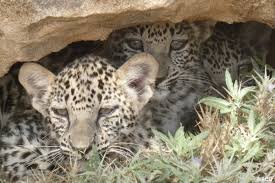Sharjah, UAE – A rare Arabian leopard cub has been born in the Sharjah Breeding Centre for Endangered Arabian Wildlife, bringing new hope for the survival of this critically endangered species. The birth was announced by the Environment and Protected Areas Authority (EPAA), marking an important milestone in conservation efforts for the Arabian leopard, one of the rarest big cats in the world.
A Special New Arrival
The birth of the cub is a major achievement, as Arabian leopards are extremely rare. These majestic creatures once roamed across the Arabian Peninsula but have now almost disappeared due to habitat loss, poaching, and declining prey. Experts believe that fewer than 200 Arabian leopards remain in the wild, making each new birth crucial for the species’ survival.

According to the EPAA, the cub was born in good health, and both the mother and baby are being closely monitored by specialists at the breeding centre. The team is ensuring that the cub receives the best care, giving it a strong chance of thriving. The breeding centre has dedicated professionals who work around the clock, making sure the cub is fed properly and kept in a safe and stress-free environment. This hands-on approach is necessary to increase the survival rate of young cubs, as they are vulnerable in their early stages.

What This Means for Conservation
This birth is part of a larger conservation program dedicated to saving the Arabian leopard from extinction. The Sharjah Breeding Centre has been working for years to protect and increase the population of these leopards through breeding programs, habitat restoration, and public awareness campaigns. The centre’s breeding initiatives include careful genetic selection to ensure a diverse and strong population.
Conservationists hope that through such efforts, Arabian leopards can eventually be reintroduced into the wild in protected areas. The UAE has been at the forefront of these initiatives, proving its commitment to preserving its natural heritage. Wildlife experts believe that the success of the breeding program in captivity is an important first step toward long-term conservation. The next challenge will be finding suitable habitats where reintroduced leopards can thrive without the threat of poaching or conflicts with humans.
The Arabian Leopard: A Rare and Beautiful Species
The Arabian leopard (Panthera pardus nimr) is smaller than other leopard subspecies but is just as powerful and graceful. It has a golden-yellow coat covered in black rosettes, helping it blend into its rocky, mountainous habitat. This species is known for its elusive nature, making it even harder to spot in the wild.
Unlike its African and Asian relatives, the Arabian leopard faces severe threats due to human activities. Illegal hunting, deforestation, and conflicts with livestock farmers have driven the species to the brink of extinction. However, breeding programs like the one in Sharjah offer hope that the Arabian leopard population can recover.
The Arabian leopard is a top predator in its ecosystem, playing a vital role in maintaining a balanced environment. When these leopards disappear, it disrupts the food chain, leading to overpopulation of certain prey species, which can negatively impact vegetation and other wildlife. Protecting the Arabian leopard also means protecting the overall health of the environment.
UAE’s Role in Wildlife Conservation
The UAE has been actively involved in wildlife conservation, protecting several endangered species through dedicated programs and reserves. Organizations like the EPAA work tirelessly to raise awareness, enforce protection laws, and create safe habitats for animals in danger.
The birth of this Arabian leopard cub is a symbol of the UAE’s ongoing commitment to conservation. Officials have stated that they will continue working to protect the species and encourage more breeding successes in the future.
Aside from leopards, the UAE has also taken steps to protect other native wildlife, such as the Arabian oryx and houbara bustard. These efforts show that conservation is a priority for the country, not just for its biodiversity but also for future generations to appreciate and enjoy the natural beauty of the region.
Challenges Ahead and the Importance of Public Support
While the birth of the Arabian leopard cub is a step in the right direction, there is still a long way to go to ensure the species’ survival. Conservation efforts require ongoing support from governments, wildlife organizations, and the public. The biggest challenges include securing large enough habitats for reintroduction, reducing conflicts with local communities, and increasing awareness about the importance of protecting wildlife.
Education and awareness play a crucial role in conservation. Many people are unaware of how close the Arabian leopard is to extinction. Public campaigns, school programs, and media outreach can help people understand why these animals are important and what they can do to help. Encouraging responsible tourism and enforcing stricter penalties for poaching and habitat destruction are also key to ensuring the species’ survival.
A Future for the Arabian Leopard
With strong conservation measures in place, experts believe there is still a chance to save the Arabian leopard. Programs like the one in Sharjah serve as a model for other countries in the region to follow. If more governments and organizations invest in conservation, the dream of seeing Arabian leopards roaming freely in the wild again may become a reality.
For now, the birth of this cub is a reason to celebrate. It’s a reminder that every effort counts in the fight to protect endangered species. The journey to saving the Arabian leopard is far from over, but moments like this give hope for a brighter future for these magnificent animals. Conservationists stress that continued investment in breeding programs, habitat protection, and public education will be crucial in the coming years. With ongoing efforts and cooperation between different stakeholders, the Arabian leopard may one day make a strong comeback in the wild.
Also read: UAE Strengthens Wildlife Protection with New Laws to Save Nature













